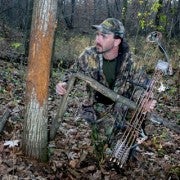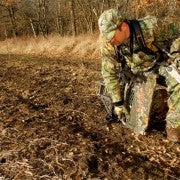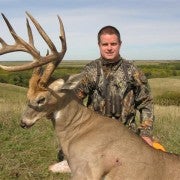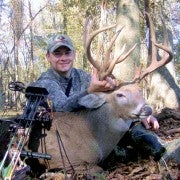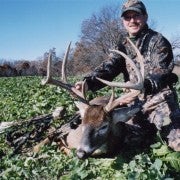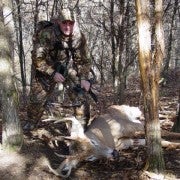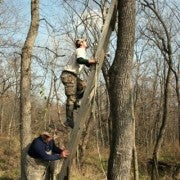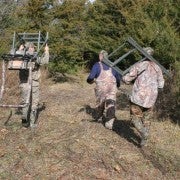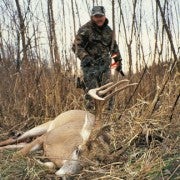Bowhunting tip: the “three sit” rule
Bob McNally 09.23.13
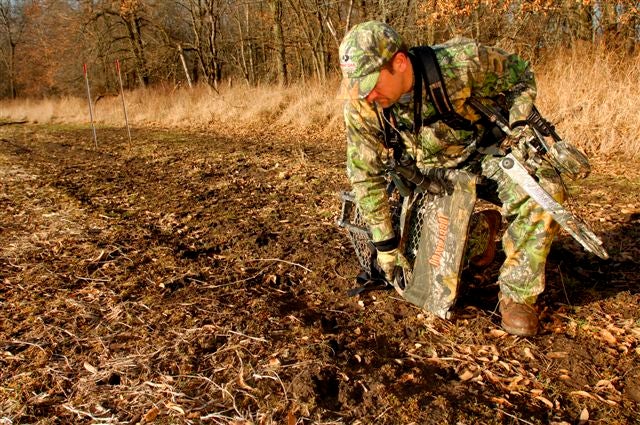
One of the hottest bow spots I ever discovered for whitetail deer was a bust of the first order. In fact, in hunting that place for nearly a week I never had a chance to arrow a decent deer, not even a doe.
It was a secluded spot on a private Northern Illinois duck club where Boone and Crockett bucks had been seen (I saw one, too, scouting). Never had I hunted mega-buck sign like that spot boasted.
It was strip of woods abutting a brush-tangled creek, with an impenetrable beaver pond/swamp beyond the stream. A 20-yard wide strip of hardwoods ran into the creek off an oak ridge forming a “T,” with a cut corn field on one side of the woods “T,” soybeans on the other. Above the fields was a 100-acre hardwood ridge, and the “T” strip was a natural route for bucks working down into the fields and across the creek into the swamp. Trails and fresh buck sign were everywhere. Scraps the size of a Toyota truck hood were spotted along the creek and in the “T” strip. Chest-high rubs were everywhere. Some on cedars as big around as my upper thigh, with bark whittled away down to the white meat of the trunk.
I checked the wind, located what I knew was a hot tree, and hung a stand. I was so confident of nailing a heavy buck there that first afternoon I never sat down in my portable stand. I felt the same way all the next morning, and that following afternoon. In fact, during the next four days I just knew a monster buck would show.
But he didn’t.
In fact, in nearly a week of solid hunting the spot I never saw a mature buck from the stand. Not one. And not many other deer either. When the hunt was over and I hadn’t even drawn my bow, I was puzzled, but mostly mad at the rookie mistake I made for sitting so long and hunting so hard in just one spot. Had I kept on the move, I more than likely would have tagged a good buck on that Land Of Lincoln, deer-rich farm.
I really don’t know why that place failed for me, but I’m sure I contaminated the spot somehow. Perhaps other hunters were in the area, or coyotes or dogs were the culprit. It doesn’t matter, really, because since then I’ve learned to live by the “three-sit rule.” This personal McNally edict dictates that no matter how great a stand seems; no matter how phenomenal the “sign” of giant bucks the location holds; if after sitting the place for three consecutive stand periods I don’t connect on a deer, I’m gone. Vamoose. Hasta la bye-bye. Find something better.
That doesn’t mean I’ll move far to another spot, which may be only 100 to 150 yards distant. It also doesn’t mean I won’t return to the hot spot in a couple weeks, or in a month or more. But if a place doesn’t produce something substantial over “three sits,” I’m convinced wise bowmen should vacate. This is especially true when time is of the essence, as when making special trips to distant whitetail Meccas.
I didn’t come to this conclusion lightly. Only through years of busted buck hunts to places far and wide have I decided on the three-sit whitetail rule. Something else I’ve learned, too, is that usually the first time or two a bowman hunts a spot is when he arrows a trophy-class buck there. Six of the eight best bucks I’ve taken with a bow were arrowed the first time I hunted a stand. The other two were shot within the “third sit” dictum.
This bowhunting rule of thumb makes a lot of sense for several reasons. First and foremost, mature bucks are plenty sharp, far more alert and responsive to their senses than even the best bowhunter. So if you’re religiously hunting a hot-sign stand, it eventually will alert deer you’re in the neighborhood, and they’ll respond accordingly. That’s almost guaranteed.
Sometimes I’ve had good results by relocating a stand just 100 yards away from the initial spot I bowhunted, usually after the third try at the first spot. Last year in Georgia, for example, my sons and I were working hard to reduce the doe population on our lease. It was late in the rifle season, but we still bowhunted our little 250-acre slice of whitetail heaven. But as the season progressed deer became incredibly spooky. First weekend of bow season, between three of us we had over 50 deer in bow range. By January, getting any deer within bow range was an accomplishment, and the mature does we wanted were as slick as Houdini.
One old doe with a distinctive notched ear I played chess with for two weekends. The first weekend I watched her walk a trail to within 70 yards of my stand, stop, catch the wind with her nose high in the air, then circle until she got directly down from my scent. She then spun around and slipped off quickly and quietly.
During the second weekend I moved my tree stand off to the side of the trail where I’d seen the doe spook, and arrowed her the first morning. Interestingly, as she came in range she was watching intently the tree where I had my stand the previous weekend, some 50 yards upwind. I’m convinced that doe remembered where I had my stand placed seven days earlier.
Another important element of the three-sit rule is it keeps an archer from becoming complacent, something of which too many of us are guilty. Remember, it’s bow hunting, not bow sitting. The very best and most successful whitetail chasers are always on the move, always walking, searching, scouting and hunting to locate better stand sites, more choice spots to arrow the best bucks in their woods. Consciously or not, they, too, live by the three-sit rule.
Abiding by the three-sit rule doesn’t mean a stand automatically should be hunted for three consecutive days and then abandoned. Sometimes a great stand can be set, and then not hunted for a week or more, waiting for improved conditions. Also, if I see does and yearlings, but not bucks from a stand, I’ll likely pull out of the area, without alarming does, then come back as the pre-rut approaches. Further, if a deer “makes” me, spooks, blows, and scatters other animals with it, time to leave – perhaps coming back in a week or so, setting up higher in a nearby tree, downwind or crosswind.
Finally, I don’t know many gifted bowhunters who aren’t tree stand hanging machines. They constantly are moving stands, shifting positions, looking, scouting and preparing their next archery ambush. Whether they know it or not, they, too, likely abide by the “three-sit rule.” That’s why their freezers are loaded with venison, their trophy rooms full of buster buck racks.
